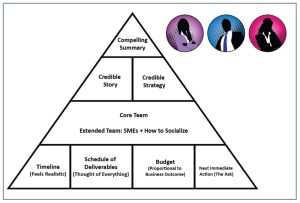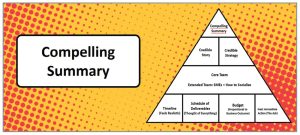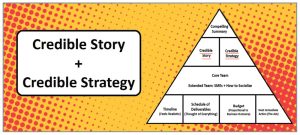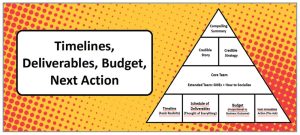Getting Alignment, Funding & Pull-Through For Your Ideas
Feature Story – By Fred Marshall and Jill Fenton
 The right approach, intentionally applied, will improve the odds of having your ideas implemented.
The right approach, intentionally applied, will improve the odds of having your ideas implemented.
A Familiar Situation: You have a new sales training idea that you want to implement.
The Complication: You’ve got no alignment, no budget and no champions … yet.
The Big Question: How do you get your idea accepted, funded and pulled through?
The bad news is that too often we get blinded by our own great ideas. We passionately lay out our plan and assume that others will react with the same enthusiasm and connect the dots for themselves on its impact and value. Sometimes it works, but most times it doesn’t. The better news is that the right approach, intentionally applied, will significantly improve the odds of having your ideas implemented.
Success lies in the ability to turn your cool sales training idea into a winning strategy and action that will drive the business outcomes your key stakeholders want. What’s the right approach?
Get organized. Divide and Conquer. Run interference. This seems simple on the surface, but the devil is in the details. Leveraging the Pyramid of Power (Figure 1) is an easy way to stay focused on the functional lenses of our key stakeholders, sales, marketing and training, as you work to integrate your initiatives into the organization.
Get Organized and Build A Compelling Summary
The first step is to ensure that your idea can be communicated in a way that immediately resonates with all stakeholders. It starts with developing a compelling summary (Figure 2). The purpose of the compelling summary is not to get them to say “yes.” It’s to get them to say “sounds interesting. Tell me more.”
Some strategic pre-work is necessary to build your compelling summary. What’s your idea in a single sentence? What business or functional need should it satisfy (sales, marketing, training, sales ops)? List the main things it will deliver. Who would most likely be impacted and in what ways? What’s at stake for them? What are the consequences of not taking this action? The answers to these questions can then be turned into a compelling summary that’s specific to each of your functional stakeholders. Keeping your summary clear, credible, and brief is the key to making it compelling.
There’s a proven three-point format that works great for developing your compelling summary:
Point 1: Start with “You know how…” (people + problem + impact). Using emotional words will capture the reality of how people feel: struggling, stressed, frustrated, etc.
“You know how our sales force is struggling to grow the business – our numbers are flat and a new competitor is planning to launch next year just as we are about to launch our new indication.”
Point 2: Continue with “Well, we have a way to…” (problem solved). Be sure to position the idea as the solution and link it to how it solves the problem and avoids the consequences of inaction.
“Well, we think we have a way to elevate our sales force’s competitive readiness by developing a more robust customer engagement model that will help return to growth, launch our new indication and defend against competitive attack.”
But don’t stop here. The third point is critical to powering the change by getting each stakeholder fired up and ready to act.
Point 3: Finish by stating the benefit to each stakeholder’s function. Anticipate each stakeholder’s stress points and make sure they are reduced or eliminated while communicating what your plan will do for them personally and/or professionally.
To the senior vice president of sales:
“It will be designed to be easy for our managers to coach and pull through, integrate with our existing field contact report, align with our new hire profiles, and directly support our new indication launch.”
To the marketing director:
“It will be designed to be easy to align to our brand strategy – and enhance our marketing tactics through better face-to-face execution. We see it as a brand strategy amplifier.”
To the director of sales training:
“It will be designed to be integrated with both initial and advanced sales training, our competencies, the way our managers coach, and will ultimately help sales training become an even better strategic partner to the field.”
 Once your stakeholders express interest, you can articulate your approach. A winning approach includes both a credible story and a credible strategy (Figure 3). A credible story is one that passes a couple of tests. It resonates on an intuitive level and it stands up under a rational, more deliberate deep dive. It builds on the momentum generated by your compelling summary and releases the energy and motivation for others to act.
Once your stakeholders express interest, you can articulate your approach. A winning approach includes both a credible story and a credible strategy (Figure 3). A credible story is one that passes a couple of tests. It resonates on an intuitive level and it stands up under a rational, more deliberate deep dive. It builds on the momentum generated by your compelling summary and releases the energy and motivation for others to act.
An effective way to build the story is to begin with the end in mind and articulate your intention, not just your idea. Clearly state what you want the stakeholder(s) to perceive differently, think differently and do differently. Describe the situation and then give two or three facts that directly support the reality of the situation. Next, give a description of what is potentially at stake and include two to four compelling challenges the organization faces if the situation isn’t addressed. Follow up by asking the question that sets up your new idea and then answer the question with your detailed approach. Be sure that your approach addresses the organizational challenges you cited. When your credible story and strategy are technically sound, they leave people thinking, “this could work.”
The right team members simplify everything. Identify the potential team members of your core team, including a strong team lead who will manage the project and oversee timelines, deliverables and budget (Figure 4). Make recommendations on the extended team, but be open to
suggestions from key stakeholders. A common mistake is to build too large a team. With too many stakeholders you end up with the least common denominator. It’s a recipe for spreading the risk and invites everyone to feel they need to design the solution. This results in an average solution. A better approach is to select a handful of highly competent subject matter experts. Select strategic stakeholders who can provide functional perspective and be champions and advocates. Listen deeply to them and give them a stake in the project’s success. By leveraging their internal credibility and allowing them to strategically socialize the project, you will create buyin and momentum.
 Success comes from keeping an eye on the big picture, paying attention to detail and concentrating on doing a handful of things really, really well. Set the context for the big picture by creating one PowerPoint slide with the overall timeline on it. Create another slide with the schedule of deliverables (Figure 5). When developing your budget, use the 5 percent rule: The total budget should be no more than 5 percent of the expected value of the impact of your cool new idea. So, if you’re planning to generate an additional $100 million in revenue, you can spend up to $5 million, at the most, to bring it about.
Success comes from keeping an eye on the big picture, paying attention to detail and concentrating on doing a handful of things really, really well. Set the context for the big picture by creating one PowerPoint slide with the overall timeline on it. Create another slide with the schedule of deliverables (Figure 5). When developing your budget, use the 5 percent rule: The total budget should be no more than 5 percent of the expected value of the impact of your cool new idea. So, if you’re planning to generate an additional $100 million in revenue, you can spend up to $5 million, at the most, to bring it about.
Finally, make the next immediate step easy to say yes to. Keep the stakeholder’s functional lens top-of-mind and make the change you ask for incremental and aligned with their role, goals and concerns. Creating realistic timelines, identifying deliverables that make sense, suggesting a budget that’s appropriate to the revenue you expect to generate and putting the right team in place will make others feel like you have thought of everything. This perception will go a long way toward getting your new sales training ideas consistently approved, funded and pulled-through.
Fred Marshall is CEO of Quantum Learning. Jill Fenton is president of Quantum Learning. Email them at Fred@quantumlearninginc.com and Jill@quantumlearninginc.com.

